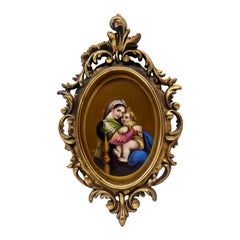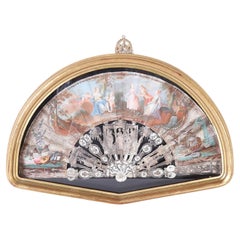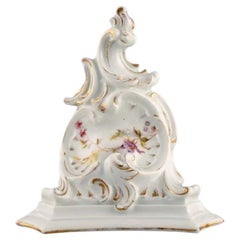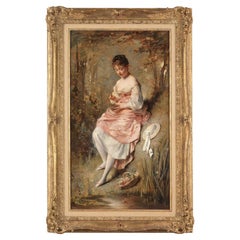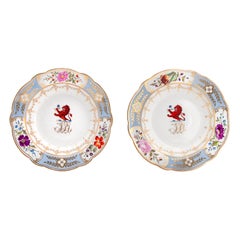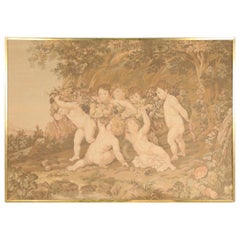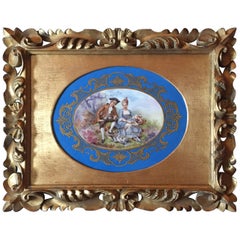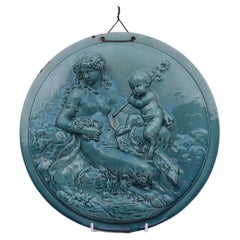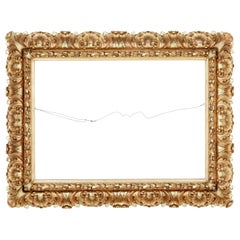Rococo Revival Decorative Art
9
to
2
8
1
9
9
9
1,760
1,102
380
331
331
228
213
203
131
114
84
75
72
51
48
41
33
25
8
1
Height
to
Width
to
5
4
3
3
3
9
4
2
2
1
1
1
1
Style: Rococo Revival
Antique KPM Porcelain Style Plaque "Madonna Della Sedia" After Raphael
Located in Atlanta, GA
Antique KPM Porcelain Style Plaque "Madonna Della Sedia" After Raphael (Italian, 15th - 16th century).
A fine quality porcelain plaque with hand painted enamel surface decorated wit...
Category
20th Century French Rococo Revival Decorative Art
Materials
Enamel
Antique Italian Painted Hand Fan in a Glass Case
Located in Palm Beach, FL
Impressive 19th century Italian hand fan, remarkably preserved with silvered metal sticks and guards depicting ancient gods, palm trees and classical emblemes. The paper leaves are h...
Category
Mid-19th Century Italian Antique Rococo Revival Decorative Art
Materials
Metal
Antique Wall Console in Hand-Painted Porcelain with Flowers and Gold Decoration
Located in Copenhagen, DK
Antique wall console in hand-painted porcelain with flowers and gold decoration. Germany, 19th century.
Measures: 15 x 14 cm.
In excellent condi...
Category
19th Century German Antique Rococo Revival Decorative Art
Materials
Porcelain
Charles Joshua Chaplin 'French, 1825-1891' 'Girl with Bird's Nest' Oil on Canvas
By Charles Joshua Chaplin
Located in Los Angeles, CA
Charles Joshua Chaplin (French, 1825-1891) 'The Bird's Nest' A very fine and charming Rococo revival style oil on canvas depicting a young girl, dressed in 18th century costume and r...
Category
19th Century French Antique Rococo Revival Decorative Art
Materials
Canvas, Giltwood
Pair of Chamberlains Worcester English Porcelain Armorial Dishes
Located in Fort Lauderdale, FL
A pair of English porcelain soup dishes made by Chamberlains Worcester circa 1825.
Made circa 1825, this pair of porcelain soup dishes is an excellent example of the stunning qual...
Category
Early 19th Century British Antique Rococo Revival Decorative Art
Materials
Porcelain
Framed Antique French Cherub Tapestry
Located in New York, NY
French (19th-20th century) beige and brown tapestry depicting a scene of several cherubs on a forest hillside in a rectangular wooden frame.
Category
Late 19th Century French Antique Rococo Revival Decorative Art
Materials
Tapestry
German 19th Century Oil on Canvas Triptych of Cherubs by Ferdinand Wagner II
Located in Los Angeles, CA
Ferdinand Wagner II (German, 1847-1927) A very fine and charming triptych group of three oil on canvas laid on board titled "An Allegory to Spring" each panel depicting different playful and joyous scenes of putti and a cherubs reminiscent of spring, love and peace. The center panel depicting a seated putto, crowned with flowers, a standing putto behind him holding a sack of arrows and a seated cherub facing him next to a watchful peace dove on top resting of a flower bouquet. The left panel depicting a seated putto next to a standing putto with a freshly harvested apple. The right side panel depicting a standing cherub holding a fig branches with leaves. All three-in-one panels within individually carved giltwood frames. All panels signed at the lower left: Ferd. Wagner, circa 1890.
Ferdinand Wagner II (German, 1847-1927) was the son of Passau Ferdinand Wagner Senior, a teacher at a vocational art school who began training him professionally at a young age. After traveling to Italy in 1867-1868, he continued with his art studies at The Munich Academy of Arts led by Peter Von Cornelius and Julius Schnorr...
Category
Late 19th Century German Antique Rococo Revival Decorative Art
Materials
Canvas, Wood
1870s French Rococo Revival Yellow Blue White Enamel Pottery Wall Art Plaque
Located in New York, NY
Late 19th century, very large earthenware ceramic sculpture platter or charger, of the French Second Empire period, entirely hand painted in Francois Boucher style, the romantic and ...
Category
1870s French Antique Rococo Revival Decorative Art
Materials
Enamel
19th-C. English Rococo Revival Majolica Ruth & Wheat Wall Plaque or Bread Tray
Located in Philadelphia, PA
A scarce and unusual antique English Majolica harvest themed, Rococo Revival style bread tray, circa 1850-1880, maker unknown.
The central image is modeled on the Book of Ruth, fro...
Category
Mid-19th Century English Antique Rococo Revival Decorative Art
Materials
Earthenware
Related Items
Italian 19th Century Porcelain Plaque of Madonna della Primavera, after Barabino
By Nicolò Barabino
Located in Los Angeles, CA
A very fine Italian 19th century porcelain plaque of Madonna della Primavera ("Madonna detter Primavera with Bambino"), after Nicolò Barabino (1831-1891). The finely painted standing Madonna holding baby Jesus in her arms surrounded by flowers, framed in a Gothic revival style giltwood carved frame. The back inscribed: "Madonna detter Primavera - nach Barabino" and handwritten "E. Guenther, Phila". Signed lower left corner, circa 1890-1900.
Nicolò Barabino (1831–1891) was an Italian academic painter of religious and historical subjects, active in Florence and Genoa.
He was born in Sampierdarena. His initial studies were at the Genovese Accademia Ligustica di Belle Arti, under Giuseppe Isola. In Genoa, he befriended Maurizio Dufour. In 1857, he won the Durazzo scholarship to attend the Accademia di Belle Arti in Florence. He designed some of the lunettes completed as mosaics for the portals of the Florence Cathedral...
Category
Early 1900s Italian Antique Rococo Revival Decorative Art
Materials
Porcelain, Giltwood
H 22.5 in W 9 in D 2 in
19th Century Unmarked Sevres Hand-Painted Porcelain Plaque, Hand Carved Frame
Located in Vero Beach, FL
A circa 1880 masterpiece of a young couple feeding doves. This is a superb example of a 19th century unmarked Sèvres hand painted porcelain plaque. Signed by the artist R. Deniau. Th...
Category
1870s French Antique Rococo Revival Decorative Art
Materials
Porcelain, Wood
Large French Aubusson Pastoral Verdure Tapestry or Wall Hanging
Located in Miami, FL
A vibrant and playful Aubusson tapestry depicting the typical French scenery of castle surrounded by a forest with birds and river in the foreground.
...
Category
Early 20th Century French Rococo Revival Decorative Art
Materials
Wool
Italian Hand Painted Japanese "SATSUMA" Vase Print
Located in Scandicci, Florence
Extra large art print of a Japanese "SATSUMA" vase. Printed by hand on engraving paper with an antique star press. Completely hand-colored by our skil...
Category
21st Century and Contemporary Italian Rococo Revival Decorative Art
Materials
Paper
Italian Contemporary Hand Painted Botanical Print "Iris"
Located in Scandicci, Florence
Elegant hand-watercoloured print representing "Iris".
This botanical style print is available in 6 different natural representations to create a bright and joyful composition. In se...
Category
21st Century and Contemporary Italian Rococo Revival Decorative Art
Materials
Paper
Italian Contemporary Hand Painted Botanical Print "Magnolia"
Located in Scandicci, Florence
Elegant hand-watercoloured print representing "Magnolia".
This botanical style print is available in 6 different natural representations to create a bright and joyful composition. I...
Category
21st Century and Contemporary Italian Rococo Revival Decorative Art
Materials
Paper
Japanese Antique Silk and Cotton Tapestry
Located in Milano, IT
Wonderful and very rare Japanese tapestry made in the 1900s, made of woven silk and cotton, of absolute fineness.
The tapestry is developed in length ...
Category
Early 1800s Japanese Antique Rococo Revival Decorative Art
Materials
Fabric, Silk
Handwoven Vintage French Savonnerie Rug or Aubusson Style Tapestry
Located in Miami, FL
This colorful handmade rug was woven in Aubusson, France in the early 20th century. The rug depicts a traditional Aubusson style with floral motifs which began and are often seen in ...
Category
20th Century French Rococo Revival Decorative Art
Materials
Textile
Free Shipping
H 103.5 in W 67 in D 0.5 in
After Raffaello Sanzio 1483-1520 Raphael La Madonna della Seggiola Oil on Canvas
Located in Los Angeles, CA
A fine Italian 19th century oil painting on canvas "La Madonna della Seggiola" after Raphael (Raffaello Sanzio da Urbino 1483-1520) The circular canvas depicting a seated Madonna holding an infant Jesus Christ next to a child Saint John the Baptist, all within a massive carved gilt wood and gesso frame (all high quality gilt is original) which is identical to the frame on Raphael's original artwork. This painting is a 19th Century copy of Raphael's Madonna della Seggiola painted in 1514 and currently exhibited and part of the permanent collection at the Palazzo Pitti, Galleria Palatina, Florence, Italy. The bodies of the Virgin, Christ, and the boy Baptist fill the whole picture. The tender, natural looking embrace of the Mother and Child, and the harmonious grouping of the figures in the round, have made this one of Raphael's most popular Madonnas. The isolated chair leg is reminiscent of papal furniture, which has led to the assumption that Leo X himself commissioned the painting, circa 1890-1900.
Subject: Religious painting
Measures: Canvas height: 29 1/4 inches (74.3 cm)
Canvas width: 29 1/4 inches (74.3 cm)
Painting diameter: 28 1/4 inches (71.8 cm)
Frame height: 57 7/8 inches (147 cm)
Frame width: 45 1/2 inches (115.6 cm)
Frame depth: 5 1/8 inches (13 cm).
Raffaello Sanzio da Urbino (Italian, March 28 or April 6, 1483 - April 6, 1520), known as Raphael, was an Italian painter and architect of the High Renaissance. His work is admired for its clarity of form, ease of composition, and visual achievement of the Neoplatonic ideal of human grandeur. Together with Michelangelo and Leonardo da Vinci, he forms the traditional trinity of great masters of that period.
Raphael was enormously productive, running an unusually large workshop and, despite his death at 37, leaving a large body of work. Many of his works are found in the Vatican Palace, where the frescoed Raphael Rooms were the central, and the largest, work of his career. The best known work is The School of Athens in the Vatican Stanza della Segnatura. After his early years in Rome much of his work was executed by his workshop from his drawings, with considerable loss of quality. He was extremely influential in his lifetime, though outside Rome his work was mostly known from his collaborative printmaking.
After his death, the influence of his great rival Michelangelo was more widespread until the 18th and 19th centuries, when Raphael's more serene and harmonious qualities were again regarded as the highest models. His career falls naturally into three phases and three styles, first described by Giorgio Vasari: his early years in Umbria, then a period of about four years (1504–1508) absorbing the artistic traditions of Florence, followed by his last hectic and triumphant twelve years in Rome, working for two Popes and their close associates.
Raphael was born in the small but artistically significant central Italian city of Urbino in the Marche region, where his father Giovanni Santi was court painter to the Duke. The reputation of the court had been established by Federico III da Montefeltro, a highly successful condottiere who had been created Duke of Urbino by the Pope - Urbino formed part of the Papal States - and who died the year before Raphael was born. The emphasis of Federico's court was rather more literary than artistic, but Giovanni Santi was a poet of sorts as well as a painter, and had written a rhymed chronicle of the life of Federico, and both wrote the texts and produced the decor for masque-like court entertainments. His poem to Federico shows him as keen to show awareness of the most advanced North Italian painters, and Early Netherlandish artists as well. In the very small court of Urbino he was probably more integrated into the central circle of the ruling family than most court painters.
Federico was succeeded by his son Guidobaldo da Montefeltro, who married Elisabetta Gonzaga, daughter of the ruler of Mantua, the most brilliant of the smaller Italian courts for both music and the visual arts. Under them, the court continued as a centre for literary culture. Growing up in the circle of this small court gave Raphael the excellent manners and social skills stressed by Vasari. Court life in Urbino at just after this period was to become set as the model of the virtues of the Italian humanist court through Baldassare Castiglione's depiction of it in his classic work The Book of the Courtier, published in 1528. Castiglione moved to Urbino in 1504, when Raphael was no longer based there but frequently visited, and they became good friends. He became close to other regular visitors to the court: Pietro Bibbiena and Pietro Bembo, both later cardinals, were already becoming well known as writers, and would be in Rome during Raphael's period there. Raphael mixed easily in the highest circles throughout his life, one of the factors that tended to give a misleading impression of effortlessness to his career. He did not receive a full humanistic education however; it is unclear how easily he read Latin.
Early Life and Works
His mother Màgia died in 1491 when Raphael was eight, followed on August 1, 1494 by his father, who had already remarried. Raphael was thus orphaned at eleven; his formal guardian became his only paternal uncle Bartolomeo, a priest, who subsequently engaged in litigation with his stepmother. He probably continued to live with his stepmother when not staying as an apprentice with a master. He had already shown talent, according to Vasari, who says that Raphael had been "a great help to his father". A self-portrait drawing from his teenage years shows his precocity. His father's workshop continued and, probably together with his stepmother, Raphael evidently played a part in managing it from a very early age. In Urbino, he came into contact with the works of Paolo Uccello, previously the court painter (d. 1475), and Luca Signorelli, who until 1498 was based in nearby Città di Castello.
According to Vasari, his father placed him in the workshop of the Umbrian master Pietro Perugino as an apprentice "despite the tears of his mother". The evidence of an apprenticeship comes only from Vasari and another source, and has been disputed—eight was very early for an apprenticeship to begin. An alternative theory is that he received at least some training from Timoteo Viti, who acted as court painter in Urbino from 1495.Most modern historians agree that Raphael at least worked as an assistant to Perugino from around 1500; the influence of Perugino on Raphael's early work is very clear: "probably no other pupil of genius has ever absorbed so much of his master's teaching as Raphael did", according to Wölfflin. Vasari wrote that it was impossible to distinguish between their hands at this period, but many modern art historians claim to do better and detect his hand in specific areas of works by Perugino or his workshop. Apart from stylistic closeness, their techniques are very similar as well, for example having paint applied thickly, using an oil varnish medium, in shadows and darker garments, but very thinly on flesh areas. An excess of resin in the varnish often causes cracking of areas of paint in the works of both masters. The Perugino workshop was active in both Perugia and Florence, perhaps maintaining two permanent branches. Raphael is described as a "master", that is to say fully trained, in December 1500.
His first documented work was the Baronci altarpiece for the church of Saint Nicholas of Tolentino in Città di Castello, a town halfway between Perugia and Urbino. Evangelista da Pian di Meleto, who had worked for his father, was also named in the commission. It was commissioned in 1500 and finished in 1501; now only some cut sections and a preparatory drawing remain. In the following years he painted works for other churches there, including the Mond Crucifixion (about 1503) and the Brera Wedding of the Virgin (1504), and for Perugia, such as the Oddi Altarpiece. He very probably also visited Florence in this period. These are large works, some in fresco, where Raphael confidently marshals his compositions in the somewhat static style of Perugino. He also painted many small and exquisite cabinet paintings in these years, probably mostly for the connoisseurs in the Urbino court, like the Three Graces and St. Michael, and he began to paint Madonnas and portraits. In 1502 he went to Siena at the invitation of another pupil of Perugino, Pinturicchio, "being a friend of Raphael and knowing him to be a draughtsman of the highest quality" to help with the cartoons, and very likely the designs, for a fresco series in the Piccolomini Library in Siena Cathedral. He was evidently already much in demand even at this early stage in his career.
Influence of Florence
Raphael led a "nomadic" life, working in various centres in Northern Italy, but spent a good deal of time in Florence, perhaps from about 1504. Although there is traditional reference to a "Florentine period...
Category
19th Century Italian Antique Rococo Revival Decorative Art
Materials
Gesso, Canvas, Wood
H 57.88 in W 45.5 in D 5.13 in
Chamberlains Worcester Plate Porcelain Dragon in Compartments Ptn. 75, Ca 1800
Located in Lincoln, Lincolnshire
This is a good quality porcelain Plate or Dish, all hand painted in the Dragon in Compartments pattern, Number 75, by Chamberlains Worcester, dating to the George 111rd years, circa ...
Category
Early 19th Century English Antique Rococo Revival Decorative Art
Materials
Porcelain
Two KPM Porcelain Plaques in Giltwood Frames after Murillo
By Bartolomé Esteban Murillo, KPM Porcelain
Located in London, GB
These wonderful porcelain plaques were created in circa 1860 by the prestigious Konigliche Porzellan Manufaktur or KPM (German, founded in 1763). The plaques feature beautiful paintings based on works by the famous Seville-based Baroque artist, Bartolome Esteban Murillo (Spanish, 1618-1682).
One plaque is decorated after Murillo...
Category
Late 19th Century German Antique Rococo Revival Decorative Art
Materials
Porcelain, Giltwood
Antique Chinese Hand Painted Fan with Calligraphy, c. 1900
Located in Jimbaran, Bali
A Chinese hand-painted fan with hand-painted calligraphy (with two different drawing on either side). The fan's frame is crafted from bamboo and also includes wood engravings. The calligraphy features flowers, leaves and a grass hopper...
Category
Early 20th Century Chinese Rococo Revival Decorative Art
Materials
Bamboo
Free Shipping
H 12.6 in W 19.69 in D 0.79 in
Previously Available Items
Glazed Pottery Wall Plaque After Clodion
Located in East Geelong, VIC
This late 19th century glazed pottery wall plaque has been made in the style of Claude Michel (1738-1814), known as Clodion, a French sculptor in t...
Category
1890s French Antique Rococo Revival Decorative Art
Materials
Earthenware
Large Impressive 19th Century Rococo Revival Gilt Frame
Located in Debenham, Suffolk
Large impressive 19th century Rococo revival gilt frame, circa 1890
Great opportunity to turn this decorative frame into a fantastic wall decoration. Inner slip with carved pods a...
Category
Late 19th Century French Antique Rococo Revival Decorative Art
Materials
Giltwood
Rosary with Wood Querubins and Crepom Paper
Located in Jundiaí, SP
This Rosary is made with crepom paper pompons and cross, a work of D. Lilia Fonseca, and hand wood carving querubins, made by Rondinelly Santos, D. Lilia's nephew, and a sacred art s...
Category
2010s Brazilian Rococo Revival Decorative Art
Materials
Imbuia, Reclaimed Wood
Pair of Fine Architectural Gilded Wood Medallions, circa 1790
Located in Austin, TX
A pair of heavy high quality architectural gilded wood medallions end of 18th century or early 19th century.
Oak wood gilded hand carved.
Maybe pieces...
Category
1790s French Antique Rococo Revival Decorative Art
Materials
Oak
19th Century Oyster Plates Newport Pattern French Porcelain
By Limoges
Located in Savannah, GA
Known as the Newport pattern, this elegant set of twelve hand-painted and gold leaf edged French porcelain oyster plates feature different colors (four in Robin's egg blue, five in b...
Category
19th Century French Antique Rococo Revival Decorative Art
Materials
Porcelain
A Well-Carved Pair of Italian Rococo Revival Carved Giltwood Wall Appliques of Floral Bouquets
Located in San Francisco, CA
A well-carved pair of Italian rococo revival giltwood wall appliques of floral bouquets; each hand-carved applique of a lush floral and foliate bouquet...
Category
19th Century Italian Antique Rococo Revival Decorative Art
H 21.5 in W 12.75 in D 2.5 in
Set of Four French Panels in the Chinese Style
Located in Atlanta, GA
Set of Four French Panels in the Chinese Style depicting Children Playing in a Pastoral Setting. Please Note These Items are Antiques and are Four of a Kind. Please Refer to our Web...
Category
19th Century French Antique Rococo Revival Decorative Art
Antique French Tapestry
Located in New York, NY
Woven tapestries are perhaps the most venerable and highly prized medium of textile art. Tapestries have been woven almost from the beginning of weaving itself, and already in ancient times, this technique was adapted to pictorial compositions as well as ornamental designs. 'Woven paintings' of this kind were known to the court arts of Egypt, the ancient Near East...
Category
19th Century French Antique Rococo Revival Decorative Art
Materials
Wool
Rococo Revival decorative art for sale on 1stDibs.
Find a broad range of unique Rococo Revival decorative art for sale on 1stDibs. Many of these items were first offered in the 20th Century, but contemporary artisans have continued to produce works inspired by this style. If you’re looking to add vintage decorative art created in this style to your space, the works available on 1stDibs include wall decorations, serveware, ceramics, silver and glass and other home furnishings, frequently crafted with ceramic, porcelain and other materials. If you’re shopping for used Rococo Revival decorative art made in a specific country, there are Europe, France, and Germany pieces for sale on 1stDibs. While there are many designers and brands associated with original decorative art, popular names associated with this style include Chamberlains Worcester, Charles Joshua Chaplin, Ferdinand Wagner II, and Royal Vienna Porcelain. It’s true that these talented designers have at times inspired knockoffs, but our experienced specialists have partnered with only top vetted sellers to offer authentic pieces that come with a buyer protection guarantee. Prices for decorative art differ depending upon multiple factors, including designer, materials, construction methods, condition and provenance. On 1stDibs, the price for these items starts at $300 and tops out at $85,000 while the average work can sell for $2,148.
Recently Viewed
View AllMore Ways To Browse
Bisazza Vetro On Sale
Della Robbia Plaques
Driftwood Wall Hanging
Egyptian Chargers
Enamel On Copper Wall Art Walnut
Flowered Green Plate
Framed Hermes Scarves
Frederick Golden Short
Hummel Plates
Insect Wall Pocket
J Smit
Joan Mayor
Kellys Heroes
Kermit Kermit Oliver Painting Oliver
Knights Of Columbus
La Pantera
Linoleum Tiles Vintage
Majolica Mermaid
